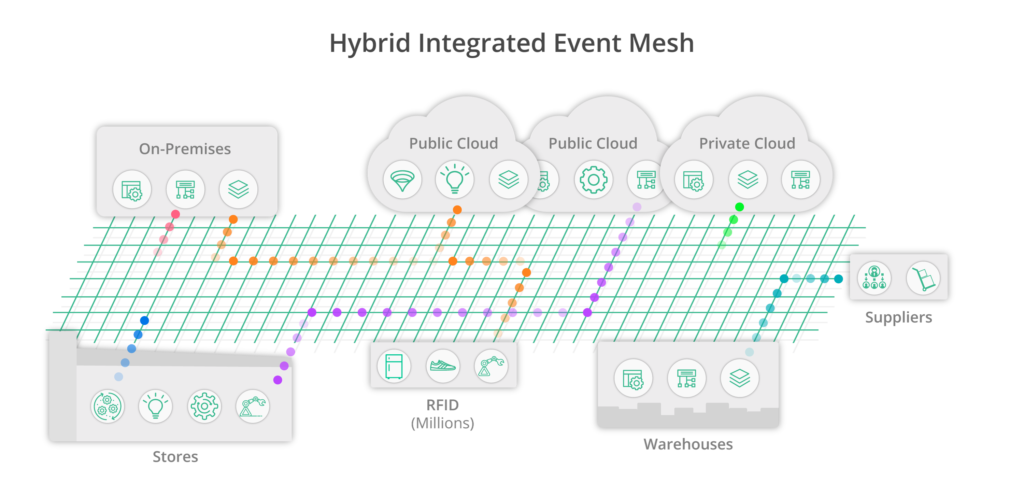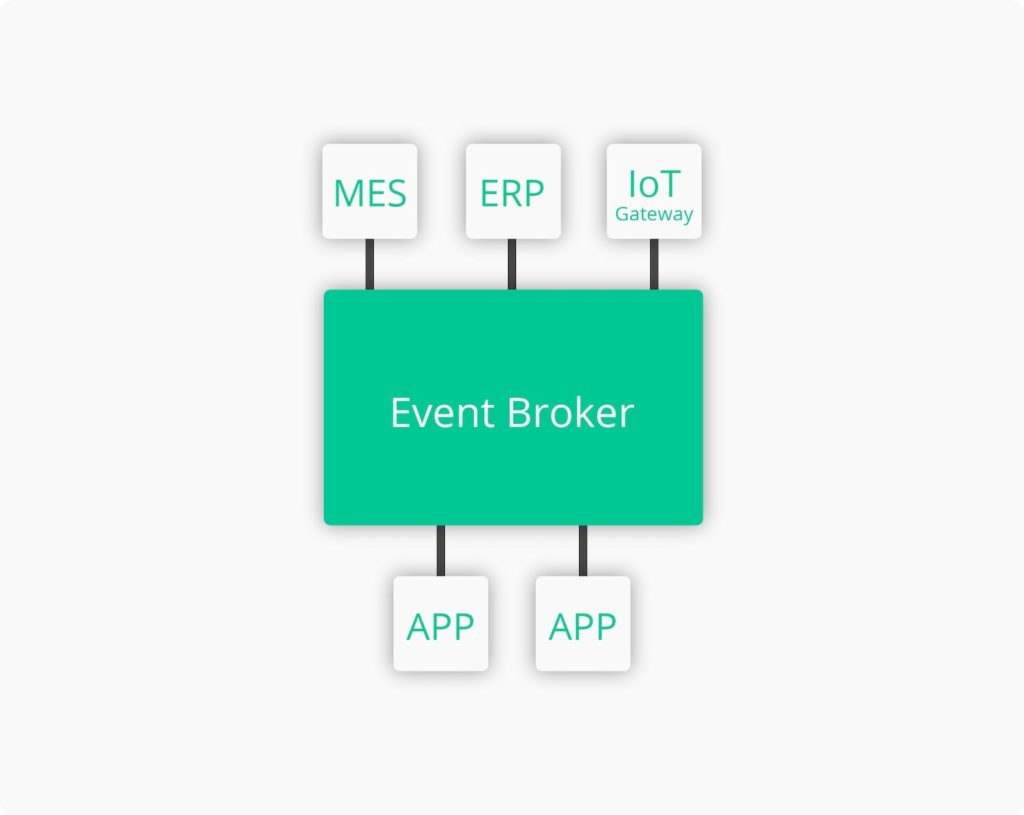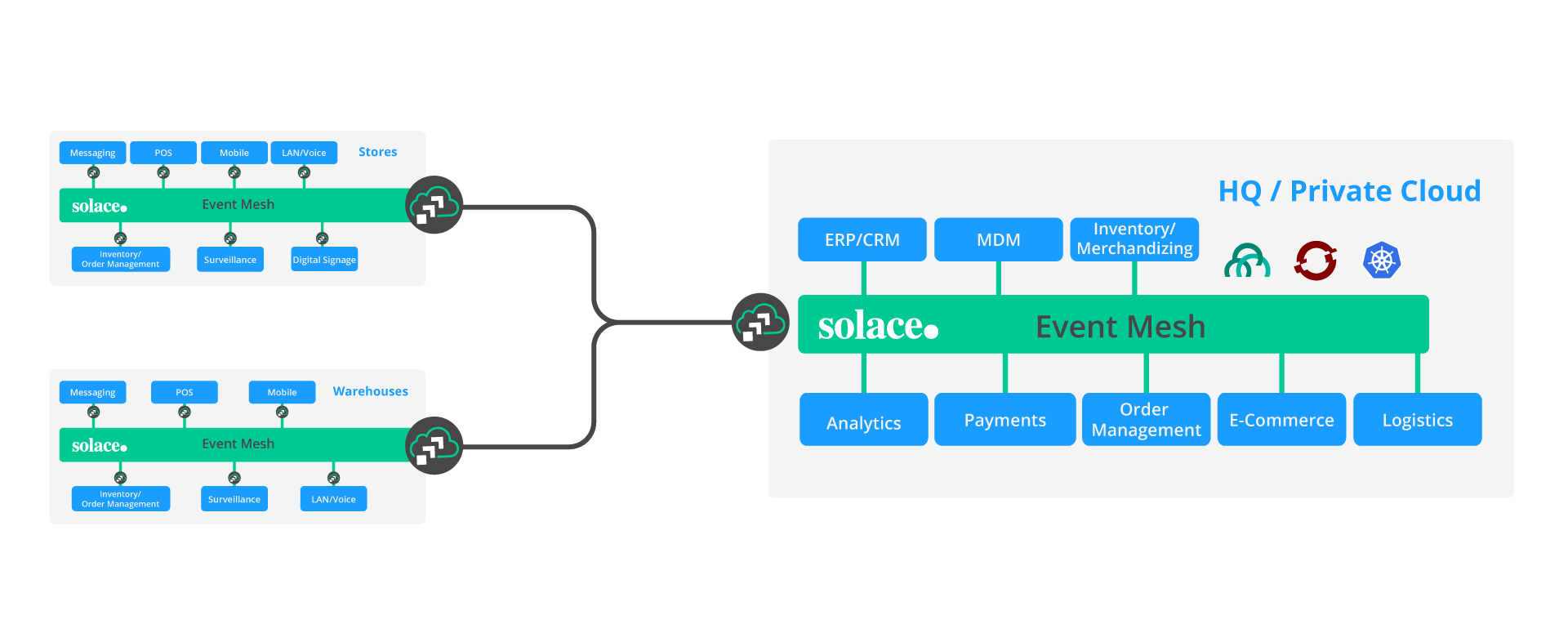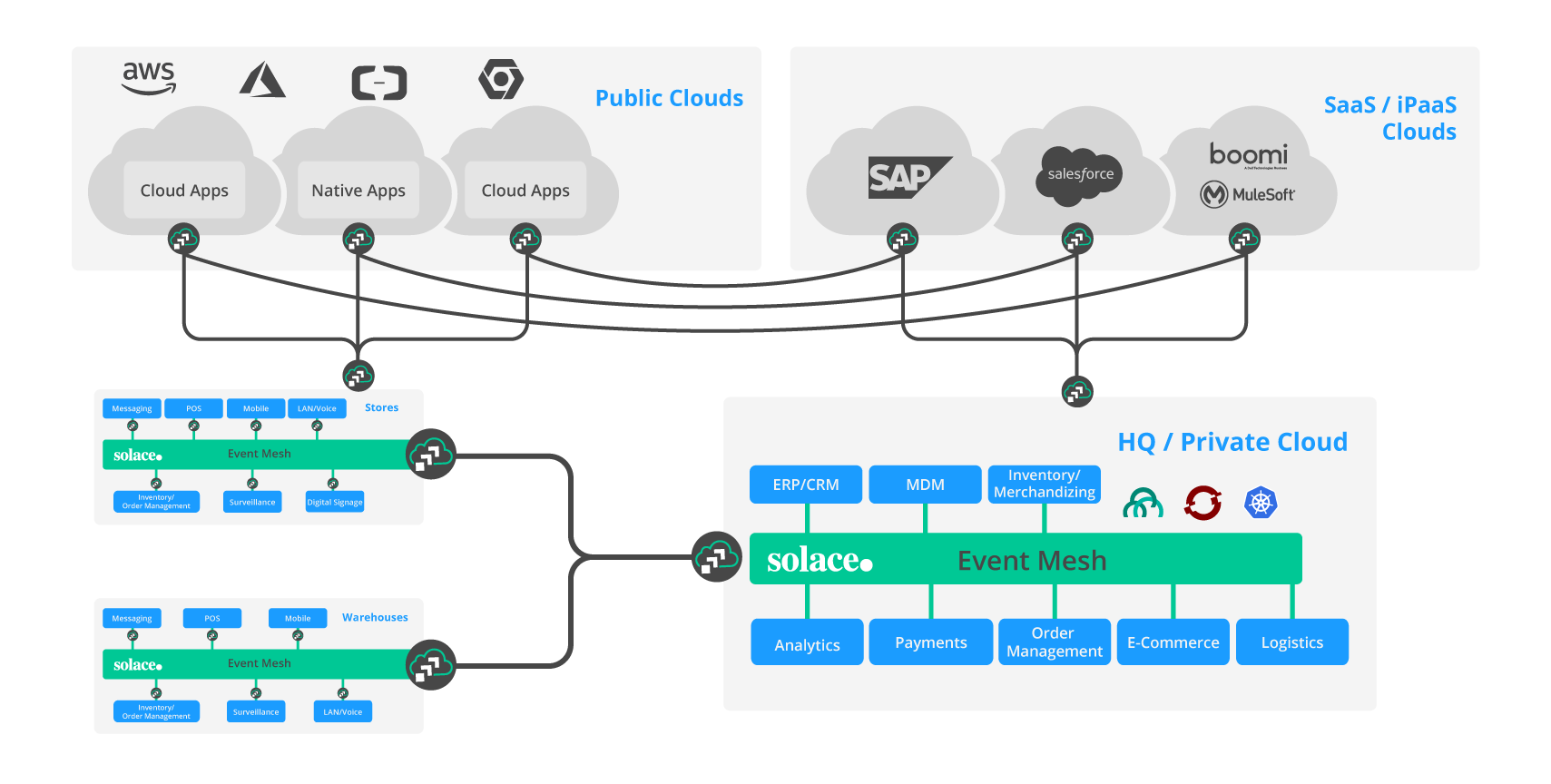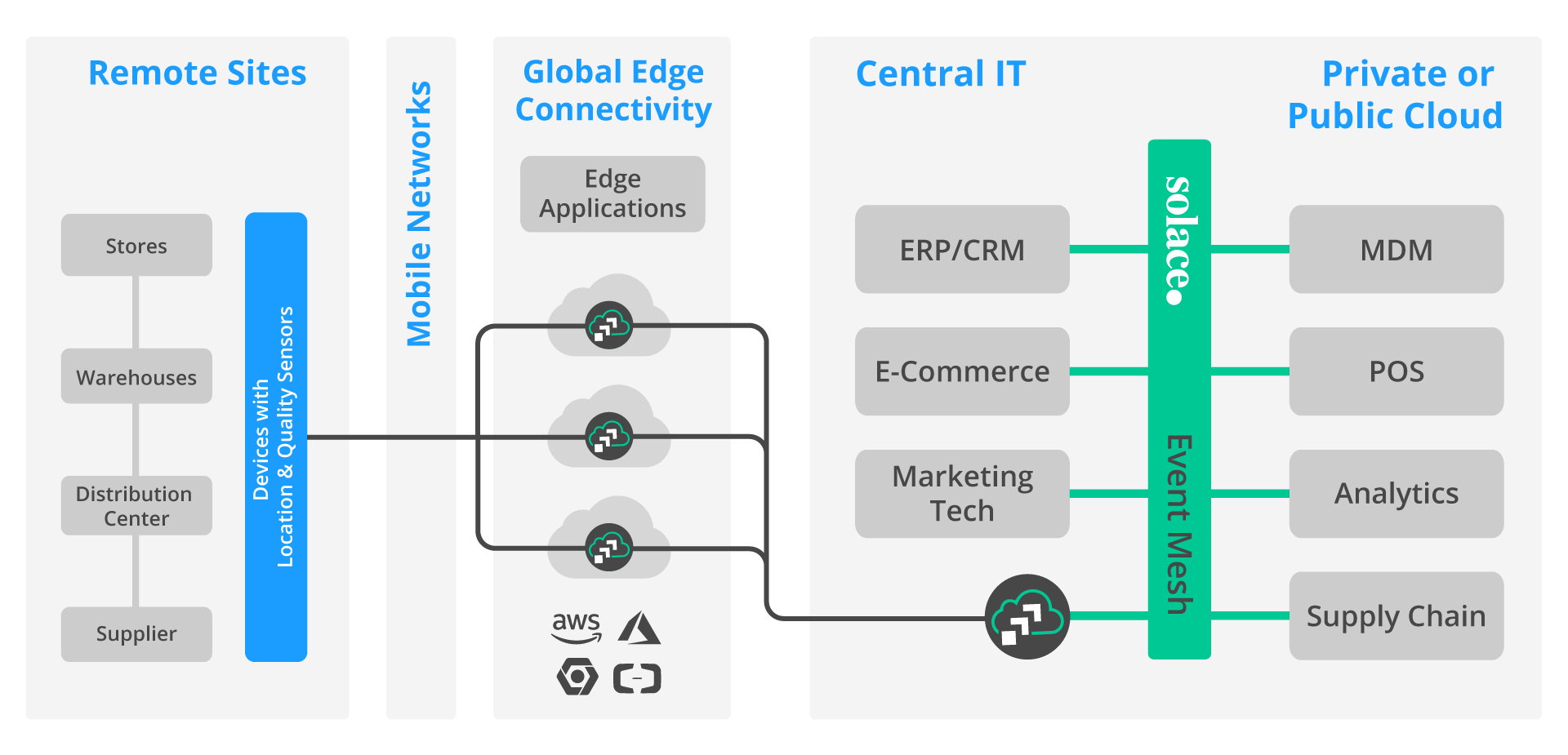Summary: An event mesh supports retail digital transformation by enabling the fast, reliable, and secure movement of events. These events (and other data) are streamed across the entire supply chain—from suppliers to customers—including applications running in a variety of environments. For large retailers with diverse systems and value chains distributed globally, an event mesh can be the digital foundation ensuring that events are routed from where they are created to where they need to be.
Event Mesh 101
Before we explore the retail digital transformation use case, it’s critical to understand what an event mesh is and how it works. An event mesh is composed of a network of interconnected event brokers. Event brokers are modern messaging middleware uniquely designed to enable event-driven apps and architectures, with support for the publish-subscribe messaging pattern, and more. This is what makes an event mesh the foundational layer to enable data movement across every environment and component of a distributed enterprise (hybrid cloud, multi-cloud, IoT, etc.).
Here’s how it works: an event broker will be deployed in an environment, and various applications (including microservices, devices, and edge gateways) will connect to it. Some will publish events (and other data) to it, and some will subscribe to various events. Then, as events get published and pushed to the broker, applications that have subscribed to those events will receive them, without delay. That’s the story for a single, local environment.
Now imagine this happening in multiple environments—including data centers, public clouds, private clouds, and across different geographies and cloud regions. Because the event brokers running in the different environments are interoperable, they seamlessly connect to enable the routing of events and other data across every environment. An application might live, for example, in a public cloud and connect to a broker in that cloud, but be subscribing to and receiving events without delay that are published by an application that lives in a datacenter on the other side of the world. That’s an event mesh at work.
An event mesh applied to retail digital transformation use cases
In a previous blog post, I talked about the urgent need for digital transformation in the retail industry and introduced the concept of the event mesh for retail. In this post, I will go in a bit more detail about the primary use cases – when digital transformation really matters and how an event mesh supports it.
We can look at retail digital transformation projects through four primary use cases:
- In-store to datacenter/HQ;
- IT modernization;
- Multi-cloud and hybrid cloud connectivity; and,
- Internet of Things for theft/loss prevention and shopping experience optimization.
1. In-store to Datacenter/HQ
Retailers are trying to modernize their stores with new technologies and service models that better attract and retain shoppers. They’re doing this with geofencing tools for online advertising, loyalty offers, in-store digital signage, personalized experience offers and smooth buy online pickup in-store (BOPIS) handoffs. However, the power is in the cumulative here. If all of these techniques go well, but the last mile fails to wow the customer, they may shop elsewhere next time.
The Disconnect Between Front-End and Back-End Systems
Consider a customer named John, who walked into a store to pick-up a pair of jeans he ordered online. After waiting in line at the pick-up counter, he learns that the pair of jeans in his size is not available in-store. John doesn’t care that he will eventually get the jeans mailed to his house for free; he is upset that he just wasted an hour of his time. What is John likely to do? Leave a bad review online because he cares as much (maybe more) about the experience as he does about how great the jeans are.
Thus, it is critical for the e-commerce, inventory, in-store, and marketing systems to communicate with each other across stores and datacenters/HQ. The integration of the back-end and front-end operations must be executed with excellence and efficiency.
A major challenge is that a store and HQ can have a variety of technologies using a mix of interfaces and protocols (payments, inventory, point of sale, digital signage, warehouses) that don’t communicate with each other. Organizational and technological silos make it challenging to deliver the personalized customer experience that is key to the retailer’s survival.
Connecting Disparate Technologies with an Event Mesh
An event mesh enables event-driven data movement between the disparate technologies and systems supporting the stores, warehouses, datacenters, merchandizing & order management departments, and even the suppliers.
Event brokers can be deployed in-store, aggregating data from various systems and streaming data/events to the datacenter/HQ and/or cloud—providing a unified event and data distribution layer across the disparate technologies.
Now, when John orders a pair of jeans from the comfort of his home, he can be notified that the jeans will be delivered next-day from a store nearby with an offer to buy a shirt at a special discount. Or, if he picks it up from the store, he will get a free personalized shopping service.
2. IT Modernization
Many retailers are migrating their ERP systems to the cloud (using SAP S/4HANA, for example) which in turn triggers modernization of their messaging infrastructure. It is common to have various legacy messaging systems in HQ that can’t connect with native digital or cloud services, and cannot keep up with the volume of data being exchanged in a modern, globally distributed enterprise.
Real-Time Events, Imagine the Benefits
Consider how you can event-enable SAP data (like a purchase order), which will trigger a notification to multiple interested applications (logistics, inventory, billing) residing on-premises and in the cloud. And let’s not forget about the external supplier who is also interested in any out-of-stock events so that they can quickly refill stock in the warehouse.
Consider the implications of being able to correlate real-time purchase data from online and in-store shoppers: you could streamline and realize cost efficiencies in warehousing, storage, shipment, and more.
Or consider the implication of being able to dynamically move your data to the cloud during peak times (Mother’s Day, Christmas, Cyber Monday, Valentine’s Day) so that your infrastructure continues to perform at its best. These opportunities demand real-time, bi-directional data flow, which can prove challenging. Data transport/routing can represent significant obstacles due to the variety of data formats, APIs and protocols used by different applications and systems. Streaming data from globally distributed facilities can also be costly, especially without edge intelligence to reduce the amount of noise being sent to the cloud.
The Architect’s Guide to Real-Time RetailHow retail IT professionals can architect for resilience and rapid response by leveraging event-driven architecture.
An Event Mesh to Move Retail Data in Real-Time
An event mesh is the solution to these problems. Event brokers can be deployed in any or all stores/warehouses, and in a central HQ (datacenter/private cloud) and connected to form an event mesh that spans them all. Events and other data can then be pushed from local applications and gateways to local brokers, where they will be broadcast to subscribing applications, no matter where they live on the mesh.
If the event brokers that compose your mesh are advanced, they can also do things like:
- Provide for standard protocol translation. For example, local brokers might receive event notifications and transmit them to regional or central HQ brokers over protocols such as MQTT or AMQP, where they are then sent to back-end systems/apps via JMS.
- Enable edge intelligence. Filtering and processing events and other data at the edge, so there’s a focus only on the events and data being subscribed to.
- Provide for WAN optimization, to reduce costs and increase performance.
- Provide security and data access controls across the mesh.
3. Multi-Cloud and Hybrid Cloud Connectivity
Another set of transformation opportunities and challenges relate to the integration of HQ and in-store applications with public clouds and the services they offer. Many retailers are creating new cloud-native applications and microservices—as well as migrating existing on-premises applications to the cloud—to leverage modern tooling, maintenance, storage, operations, and pay-as-you-go pricing. Cloud data lakes and cloud services for AI and machine learning promise to support modern use cases, such as shifting from reactive to predictive processing, and from reactive to preventative maintenance.
From Public Cloud to Hybrid/Multi-Cloud
Working with one public cloud is usually pretty straightforward, and that’s where you’re likely to start. You’ll adopt a public cloud and start developing new apps within that environment. Over time, you may start migrating legacy apps to that public cloud and begin experimenting with cloud services.
All good.
But then you’ll realize that you need a feature or capability that’s not offered by the public cloud you’re in, or you’ll want a more advanced version of a service that’s offered elsewhere. You’ll want more flexibility, the ability to mix and match capabilities from different cloud environments, and the freedom to move data and apps wherever you want. In short, you’ll want to deploy a hybrid and multi-cloud architecture and enable data to flow easily and efficiently across it.
Leverage Multiple Cloud Services & Avoid Disruption with an Event Mesh
With an event mesh, working in and across multiple public clouds and cloud regions, and integrating cloud-native apps and services with legacy systems, is straightforward. Event brokers can be deployed natively in different public cloud environments (AWS, GCP, Azure) and on-premises, and connected to form the hybrid, multi-cloud event mesh. With an event mesh set-up in this fashion you can easily:
- leverage multiple public cloud services, from different public clouds;
- add, remove and move apps throughout your system, without disrupting the system;
- migrate to the cloud in a stepwise fashion;
- integrate IoT; and,
- set-up robust disaster recovery, leveraging your multi-cloud architecture.
4. Hyper-Personalization and Loss/Theft Prevention
Another important objective of retail digital transformation is to support the tracking and tracing of products from the supply chain to the store and to the customer using RFIDs/sensors. We will begin to see more scenarios where sensors are being deployed on products (shoes, televisions) to track usage of products to develop more personalized offers and prevent theft.
The Future of IoT in Retail and its Challenges
Think about sending a notification to a loyal customer who purchases running shoes model X when the shoe is approaching end-of-life. The sensors on the shoes can continually stream use and fitness data augmenting both product manufacturing intelligence and consumer profile. The notification can include personalized product recommendations based on product use, running profile, peer groups, trends and social media inputs using machine learning. You can offer the runner a one-time replacement or continuity program for each 500 miles run; when the runner selects this offer, and chooses to pick up the shoes in-store, you up the ante by offering a free foot scan which will help with future recommendations.
Retailers are also looking to prevent theft happening at stores. RFID on high price items can go a long way in tracking items in transit and ultimately reducing revenue loss.
But there are challenges.
A major challenge is ensuring data delivery despite intermittent connectivity. After all, sensors deployed in this fashion will travel through multiple and often erratic mobile networks (as well as various WiFi-networks); sometimes they’ll be online, and sometimes they’ll be offline. This can risk the loss of events and other data before they are delivered.
Deploy Advanced Event Brokers to Avoid Data Loss
With advanced event brokers and an event mesh deployed, this challenge can be overcome. Event brokers can be deployed on a truck or ship or plane, and connected to receive all of the event notifications from the sensors on the transport. When the broker is connected to a mobile network, these events will be published to the event mesh. When mobile connectivity is unavailable, the events will get buffered by the broker and sent whenever connectivity is restored.
And with an event mesh enabling events to be routed efficiently between these products, stores, warehouses, HQ, and public clouds, not only will retailers be able to track & trace their materials from supply chain to consumers—they will also gain a better understanding of the choreography of their supply chain so they can test it and improve it to meet rising customer expectations.
Why an Event Mesh for Retail Digital Transformation? – A Summary
A retailer undergoing a digital transformation already has a lot on their plate, but these are the three steps that will ensure a successful transformation to the real-time, digital world we live in today;
- Unify physical and digital operations;
- Future-proof with an architecture that can scale, with no lock-in; and,
- Modernize piece-by-piece, at a pace that is comfortable.
Deploying a network of event brokers (in stores, warehouses, datacenters, clouds, etc.) and creating an event mesh will support all of these steps. It can take away a lot of the pain associated with getting multiple technologies in multiple environments to communicate. By deploying a broker that supports open standard protocols and open APIs, retailers can avoid vendor lock-in and be assured that old and new apps can be integrated, changed, and removed with ease.
Explore other posts from categories: Business | For Architects | Retail

